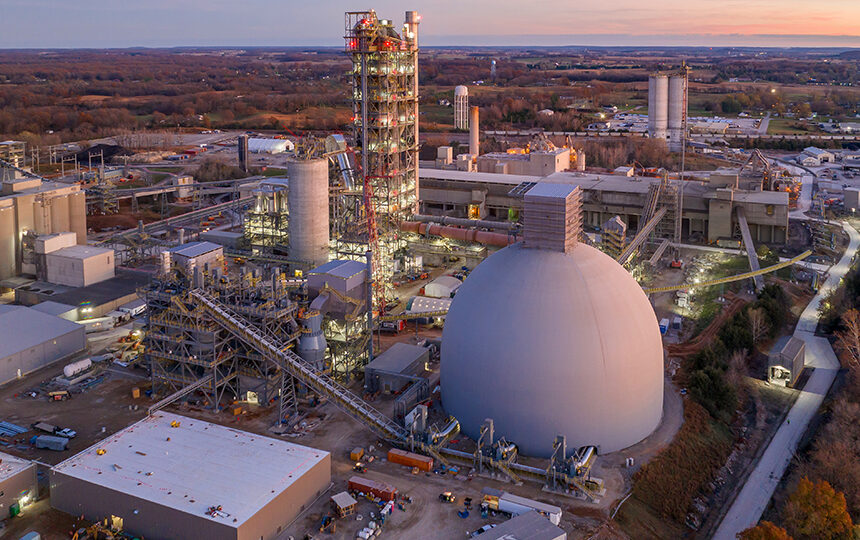As the second most widely utilized building material on the planet, behind only water, concrete is the literal foundation of the modern world. At the same time, the environmental footprint of its production is significant and is responsible for eight percent of the world’s carbon dioxide emissions. Startups and companies, including Heidelberg Materials, are stepping up to the challenge to provide cost-effective solutions.
David Perkins, Vice President of Government Affairs & Communications at Heidelberg, recently sat down with C3 to talk about the company and its work to address concrete’s carbon footprint.
While many of the companies that are pushing innovative solutions for hard-to-abate sectors tend to be startups, Heidelberg Materials celebrated its 150th anniversary last year. With more than 450 locations in North America alone and 3,000 globally, Heidelberg Materials is a leading supplier of cement, aggregates, ready-mixed concrete, and asphalt. The company operates in a vertically integrated model and controls the entire supply chain of cement, from mining its materials to their conversion into concrete.
>>>READ: Rondo Energy: Using Bricks to Decarbonize Industrial Processes
Heidelberg is taking advantage of its status as a leader by pursuing ways to reduce not only its own environmental footprint but the footprint of the industry writ large. Perkins says:
“We are recognizing that we’ve got to lean in and we’ve got to innovate and we’ve got to change how we do those types of things so that we can, not only lower our environmental footprint but ultimately the industry’s, in our effort to decarbonize.”
Heidelberg is tackling this issue through “a couple of different levers,” according to Perkins. One lever is fuel alternatives. One-third of Heidelberg’s direct, or Scope 1, emissions come from the fuel use associated with manufacturing cement into concrete. Traditionally powered by coal or petroleum coke, Heidelberg is exploring how alternative fuels can meet the thermal needs of manufacturing.
At its new facility in Mitchell, Indiana, Heidelberg has incorporated natural gas into this process, allowing it to reduce the CO2 emissions per ton of product by 30%.
Heidelberg also has a goal to make its products more circular by incorporating supplementary cementitious materials (SCMs) into its manufacturing. SCMs are used as a partial replacement for Portland cement to make concrete stronger, longer lasting, and less permeable, all at a lower cost to producers. Typically byproducts of the industry, common SCMs include fly ash, slag cement, and silica fume.
Heidelberg has zeroed in on reducing pollution from fly ash—a fine particulate matter from combusted coal—by acquiring a company that has the technology to collect the material and utilize it in concrete as an extender for traditional cement.
Outside of industrial collaboration, Heidelberg is working with the Department of Energy (DOE) to explore carbon-neutral concrete with carbon capture and storage (CCUS) at its Mitchell facility. The company has competitively earned grants to study the engineering challenges of CCUS at the facility, determine the feasibility of geologic injection of captured carbon underneath the facility, and conduct a more comprehensive cost estimate of permitting and storing carbon at Mitchell.
>>>READ: Brimstone is Accelerating Climate-Friendly Cement
Most recently, DOE awarded $500 million to Heidelberg through its Industrial Demonstrations Program, an initiative headed up by the Office of Clean Energy Demonstrations. This award will fund the construction of a post-combustion carbon capture system and the regulatory fees associated with getting it up and running.
This will not be the first carbon capture project undertaken by Heidelberg. The firm will soon launch and operate a facility in Brevik, Norway later this year that will produce the world’s first carbon-neutral concrete at scale. Heidelberg will also open another facility in Alberta, Canada by 2027. Perkins says that Heidelberg will “take this knowledge” from opening two new CCUS facilities and “leverage it for the Mitchell facility” to reduce costs and spend taxpayer dollars as effectively as possible.
Heidelberg wants to capture and store 10 million tons of CO2 cumulatively each year by 2030.
Although well-established, Heidelberg Materials is using its leadership and innovative attitude to disrupt cement and materials production and effectively reduce the environmental footprint of the concrete industry.
The views and opinions expressed are those of the author’s and do not necessarily reflect the official policy or position of C3.
